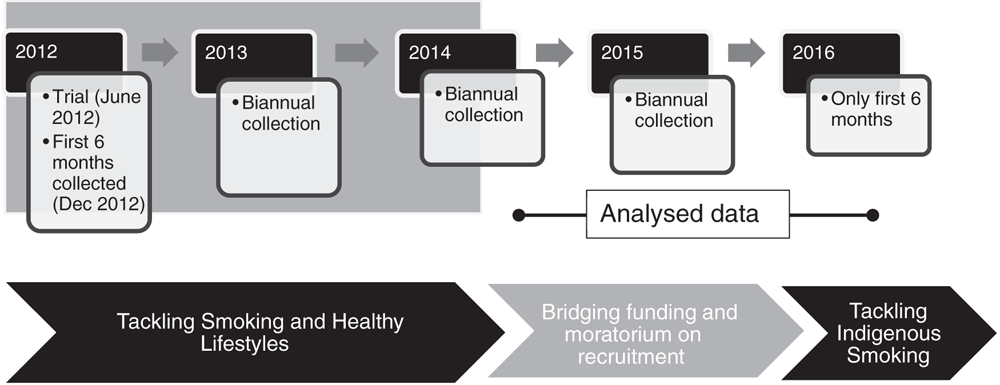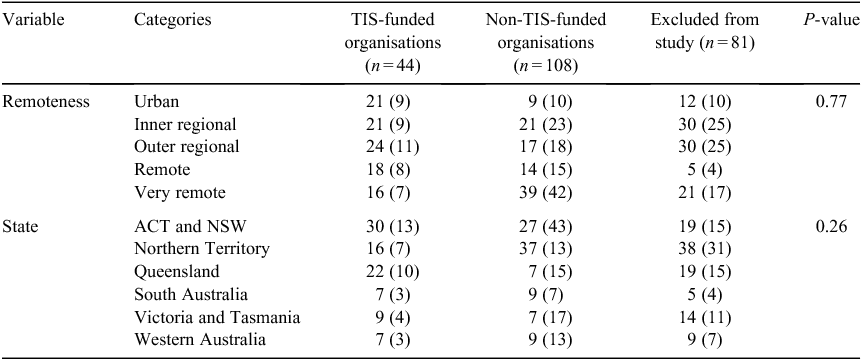Analysing aggregate clinical data to support evaluation of the Tackling Indigenous Smoking program, 2014–16
Alyson Wright A B D , Helen Cameron B , Yvette Roe C and Ray Lovett AA National Centre for Epidemiology and Population Health, Research School of Population Health, Australian National University, Building 54, Mills Road, Acton, ACT 2600, Australia. Email: raymond.lovett@anu.edu.au
B National Aboriginal and Torres Strait Islander Health Worker Association, PO Box 729, Mawson, ACT 2607, Australia. Email: policy@natsihwa.org.au
C University of Queensland, Midwifery Research Unit, Mater Research Level 2, Aubigny Place Raymond Terrace, South Brisbane, Qld 4101, Australia. Email: yvette.roe@mater.uq.edu.au
D Corresponding author. Email: alyson.wright@anu.edu.au
Australian Health Review 43(4) 441-447 https://doi.org/10.1071/AH18009
Submitted: 15 January 2018 Accepted: 5 June 2018 Published: 27 August 2018
Journal compilation © AHHA 2019 Open Access CC BY-NC-ND
Abstract
Objective The aim of this study was to assess the change in recording of client population smoking attributes (smoking status recorded and smoking status) in Tackling Indigenous Smoking (TIS)-funded services compared with non-funded services for Aboriginal and Torres Strait Islander people, 2014–16.
Methods The study included a cohort of 152 Aboriginal-community controlled services with aggregate client smoking data from 2014 to 2016. Negative binomial regression was used to assess change in smoking status recorded and smoking status between TIS and non-TIS funded organisations. The models controlled for size of client population, jurisdiction and remoteness.
Results From 2014 to 2016, the overall reporting rate (change in recording of smoking status) of client smoking status was 1.58-fold higher (95% confidence interval (CI) 1.30–1.91; P < 0.001) in TIS-funded than non-TIS-funded services after controlling for year, remoteness and their interaction. The highest change in reporting of client smoking status was for TIS-funded services in remote areas (reporting ratio 6.55; 95% CI 5.18–8.27; P < 0.001). In 2016, TIS-funded services reported higher overall levels of recording client smoking status (current, ex- and non-smokers) than non-TIS funded services (RR 1.11; 95% CI 1.00–1.28; P < 0.001). There was no significant change in the reporting of smokers, ex-smokers or non-smokers over the three reporting periods.
Conclusion The analysis shows higher reporting of the proportion of the service client population for services funded under the TIS program compared with non-TIS-funded services. Existing evidence suggests that following-up smokers with targeted clinical interventions once they have had smoking status recorded could reduce smoking rates in the long term. The public health contribution of this study has defined one method for assessing smoking attributes when using aggregate health service data. This method could be applied to future tobacco control programs in health services.
What is known about the topic? Aboriginal and Torres Strait Islander smoking prevalence is high. The Aboriginal and Torres Strait Islander primary healthcare providers’ national key performance indicators (nKPIs) are one data source that can track changes over time in smoking in clients of these services.
What does this paper add? This paper presents the first analytical study and evaluation of the nKPI dataset items on smoking.
What are the implications for practitioners? There is value in analysing routinely collected data in program evaluations. The method used in this paper demonstrates one approach that could be used to assess smoking indicators and their changes over time in TIS program evaluation.
Introduction
Targeting smokers in health service encounters with repeated unambiguous advice on smoking risks and quit options is effective.1–3 Screening of smoking status should help identify and target smokers, and helps monitor smoking prevalence in client populations over time. Recent evidence from the Talking About the Smokes study has shown that almost all Aboriginal and Torres Strait Islander smokers (who saw a doctor in the past 12 months) recalled being asked by clinicians whether they smoked, and over 75% recalled being provided with advice or a pamphlet to quit.4,5 However, other studies involving Aboriginal and Torres Strait Islander people have identified that follow-on referral pathways, including brief interventions and telephone counselling services, are not routinely offered or well targeted for this population.6–8
In 2016, the Australian Government funded the Tackling Indigenous Smoking (TIS) program, a revision of the Tackling Smoking and Healthy Lifestyle (TSHL) program, which focuses on population health approaches to tobacco control.9,10 The majority of TIS funding was provided to Aboriginal Community Controlled Health Services (ACCHSs) to develop and implement approaches to tobacco control aimed at preventing the uptake of smoking and to support smoking cessation. In addition to health promotion, many services have enhanced their efforts to deliver smoking cessation support through their clinic services. Although clinical approaches are rarely considered population approaches, clinical interventions can reinforce population measures,11 and health service data on client smoking enhances the ability to monitor changes over time.12
This study analysed aggregate service-level data from services funded to deliver primary health care to Aboriginal and Torres Strait Islander people to inform the TIS program evaluation. Our aim was to assess whether TIS-funded organisations have higher recording rates of smoking (process outcome) and decreases in smoking status in clients (impact outcome).
Methods
Study population
This study was a retrospective cohort study of primary health services for Aboriginal and Torres Strait Islander people, which included 233 services that provide national key performance indicator (nKPI) data.13 Data extracted from the client information system is provided via a secure web-based reporting tool, the Online Community Health Reporting Environment (http://www.ochrestreams.org.au/pages/welcome.aspx), and collectively analysed by the Australian Institute of Health and Welfare annually.14–16 The dataset had not been used previously in an analytical study or in program evaluation.
nKPI data
The broad purpose of nKPI reporting is to provide evidence to: (1) inform policy and program development; (2) monitor Aboriginal and Torres Strait Islander primary healthcare funding; and (3) support continuous quality improvement in the delivery of primary healthcare services to Aboriginal and Torres Strait Islander people. The nKPI data are aggregate data at the service level and include process and outcome variables on three key indicator areas: maternal and child health, preventive health and chronic disease management.
The nKPI data have been collected and reported on since July 2012, with a total of 10 reporting periods (see Fig. 1). There has been an increase in the number of services reporting nKPIs from 90 services in 2012 to 241 services in 2016. Our intention was to analyse data from 2012 to December 2016. However, there were data access restrictions on data from 2012 to June 2014 and the last 6 months of data collected in the 2016 were not available due to a data extraction fault. Hence, analyses were restricted to available data in the following: June 2014, January–December 2015 and June 2016.
Study variables
The two study outcomes of interest were: (1) the number (and proportion) of clients with a smoking status recorded in the health service records; and (2) the number (and proportion) of clients with smoking status recorded as current, ex- and non-smoker. ‘Exposure’ was defined as an organisation that was funded (n = 44/152) either directly or indirectly (via consortium arrangements) by the Australian Government’s TIS program. Other explanatory variables used in the analysis were remoteness, client numbers, jurisdiction and year of funding.
Organisations excluded from the study
Services that did not have three reporting periods of data and services in which the definition of regular clients changed over the time periods were excluded from the study.16 In total, 65% of services (152/233) were included in the study. This included 44 TIS currently funded services and 108 non-TIS-funded services. The nKPI definition of a ‘client’ is a person who has attended the health service three times in the past 2 years.14 Questions regarding smoking status only apply to adult clients, aged ≥15 years.
Statistical analysis
Descriptive analysis was undertaken to compare characteristics, such as client numbers, number of services by state or territory and remoteness, by TIS-funded status. Herein, we report total numbers and proportions.
The analytical study assessed the change in the number of clients with a smoking status recorded and outcome of smoking from 2014 to 2016. A negative binomial model (from generalised linear models (GLM), an extension of the general linear model) was used. Negative binomial regression is appropriate where explanatory variables (e.g. interval categorical variables) and errors (random effects) are not normally distributed. Using negative binomial regression allowed us to model aggregate data and to consider interactions between explanatory variables. The GLM function calculated incident rate ratios (interpreted and reported as the reporting ratio (RR)), 95% confidence intervals (CIs) and P-values. All analyses were undertaken in Stata version 13 (StataCorp, College Station, TX, USA) and graphs were prepared in Excel (Microsoft, Bellevue, WA, USA).
Data access and ethics
Data access permission and ethics approval for the research protocol (Protocol 4/2016) were granted by the Australian Government Department of Health. Results from this study have been discussed with many Aboriginal health services delivering tobacco control campaigns and TIS Australian Government program staff.
Results
Descriptive analysis of study services
In all, 152 services were included in the study, 44 of which were funded for TIS and 108 that were not (Table 1). The location of TIS- and non-TIS-funded services differed by remoteness and location (jurisdiction; Table 1). There was a higher proportion of non-TIS-funded services in remote (and very remote) areas (53% of all non-TIS-funded services; n = 57). Eighty-one services had less than three time interval data points and were not included in the analysis. There were no significant differences between services by client numbers or remoteness.
In 2016, 81 187 clients accessed TIS-funded services. This is comparable to client numbers (85 098) at non-TIS-funded services. There is variation in the proportion of clients across state and remoteness. The largest numbers of clients of TIS-funded services were from New South Wales (n = 17 147), the Northern Territory (n = 19 641) and Queensland (n = 28 162).
Ascertaining tobacco use
The proportion of clients asked about their tobacco use among TIS-funded services increased from 85% in 2014 to 88% in 2016. However, the proportion of clients asked about their tobacco use among non-TIS-funded services decreased from 84% in 2014 to 80% in 2016 (Fig. 2).
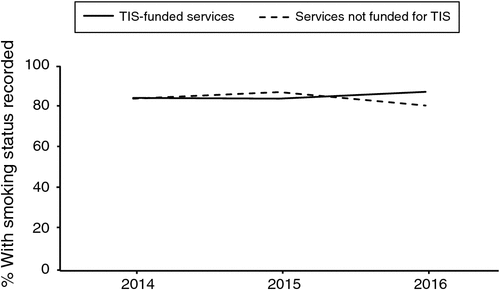
|
Among TIS-funded services, the tobacco use RR was 1.58-fold higher (95% CI 1.30–1.91; P < 0.001) after controlling for location (jurisdiction) and remoteness (Table 2). The highest change in assessing tobacco use was among TIS-funded remote services (RR = 6.55; 95% CI 5.18–8.27; P < 0.001).
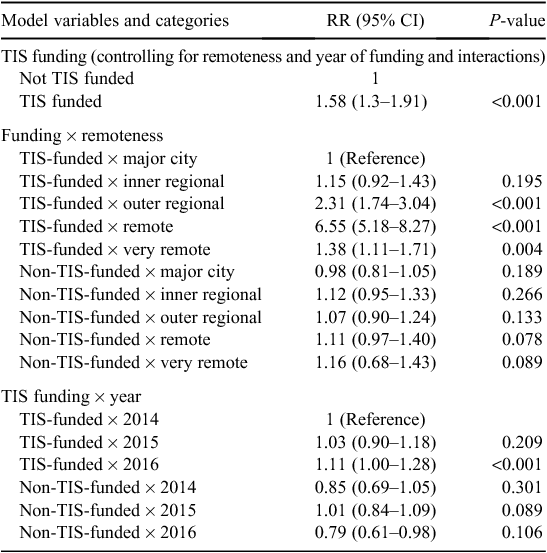
|
In 2016, the first year of the TIS program, TIS-funded services were also more likely to record smoking status among clients than non-TIS-funded services (RR = 1.11; 95% CI 1.00–1.28; P < 0.001).
Smoking status recorded
Over half of all clients (53% in 2014, 2015, 2016) attending all services were reported as current smokers (Fig. 3). Smaller proportions were reported as ex-smokers (14% in 2014 and 2015, 15% in 2016) and just over one-third were reported as non-smokers (33% in 2014, 32% in 2015 and 2016). TIS funding was not associated with any change in reporting of clients as current smokers, ex-smokers or non-smokers across the three reporting periods (Table 3).
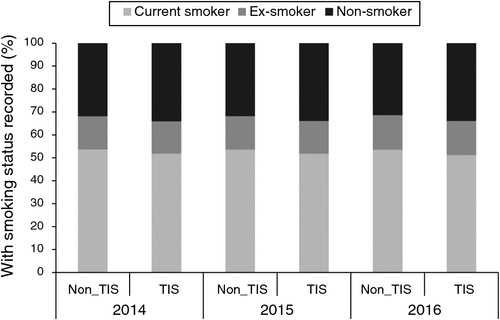
|
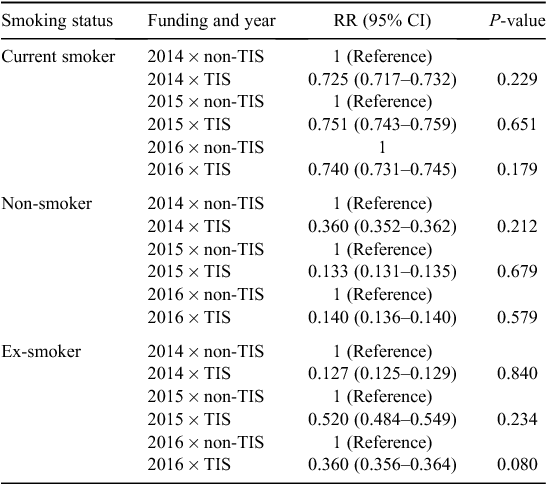
|
Discussion
The results of this study show that services funded under the TIS program (and prior TSHL program) are asking about their clients’ tobacco use at a statistically significant higher rate than non-TIS-funded services after controlling for differences due to client numbers by service, jurisdiction and remoteness (Table 2).
Recording of tobacco use has been identified as an important first step in a health systems approach to facilitate tobacco dependence treatment.17 Several studies have identified improvements to the recording of tobacco use in clinical populations after policy emphasis at the clinic level.3,18 Although not specific to the Indigenous context, health systems approaches are considered to provide tobacco cessation support and improve tobacco cessation outcomes.19 Assessment of tobacco use is an important initial step in enhancing the clinical focus to reduce the harms of tobacco use in clients and is likely to lead to better monitoring of tobacco use over time.
We cannot attribute this finding directly to TIS funding because of the study’s selection bias and the broader tobacco control policies, however services integrating procedures for tobacco control incorporating health promotion and clinical approaches together may realise improved cessation outcomes over time. Although outside the scope of the present study, follow-up identification of services that integrate clinical and health promotion work is an important future research area.
Overall, there were high levels of recording smoking status in clients across most services in this study (>80% of clients had a smoking status recorded). Although the frequency of updating smoking status cannot be determined due to variations in practices at the service level, if identified smokers are followed-up with brief intervention or quit advice and referrals to intensive support at every visit, it is likely that better outcomes in smoking cessation will eventuate among those clients.20,21
However, we found no change in smoking status outcomes in either group (TIS funded vs non-TIS funded). This is potentially not surprising given that there were only 3 years of data available for analysis. In Aboriginal and Torres Strait Islander population-level studies with data from over 10–20 years, the declines in smoking prevalence are important but modest, in the order of 1–1.5% per year.22,23 At this early stage of the revised TIS program in 2016, many services funded were still in the recruitment phase, writing their action plans, training staff and gearing up for implementation of activities and campaigns.24 It is likely that changes in smoking prevalence need longer periods of time and will not be realised until much later in the delivery phase; such lag time issues are well known in health program delivery.25
Given that this study included only 3 years and the first 6 months under the revised TIS program (2016 data), the indication of higher recording of tobacco use is important for future program monitoring. Further, our results show that remote services funded through the TIS program had increased reporting rates of clients’ smoking status than all other services. This could be the result of increased awareness among health professionals and service priorities in remote areas towards addressing tobacco use in these areas, particularly because smoking prevalence has not changed.26 Given that remote areas are not well serviced in terms of outside referral pathways for quit support,6 this process indicator in recording of smoking status is important.
Study strengths and limitations
Examining nKPI data did not require significant investment or additional resources and extended the purpose and value of routinely collected data. Using these data as part of an evaluation process can reduce the burden of data collection and analysis on services that are primarily responsible for service delivery and program implementation. However, using these data only presents a partial picture on the effectiveness of work undertaken in tobacco control, and there were significant limitations in the methods.
In particular, the study had an inherent selection bias because the 2016 TIS funding was a targeted funding round to selected services based mostly on those previously funded by the TSHL program and services considered to have greater capacity to deliver tobacco control campaigns and activities. This substantially biased the results due to lack of randomisation. As such, the services selected for funding may differ from those not funded by the TIS program. These TIS-funded services may have had greater motivation and organisational support to intervene at a population and clinical level and may, overall, be better at reporting across all nKPI data items. Other confounders may include staff numbers, overall budget numbers, proximity and number of other services in the region and other service dynamics, including the support given to motivate clinicians to act. A large number of services (n = 81) was excluded from the analysis because of missing data (n = 50) or due to changing definition of a ‘client’ (n = 31). As is often the case with real-world studies, such limitations are unavoidable but suggest that caution should be applied when interpreting the findings.
There are also some study limitations due to a lack of consistent definitions around the smoking status data collection. We are unsure how often smoking status is updated and this is not included as an nKPI indicator, which means that smoking status may have been recorded a long time ago and not updated. The category of ‘non-smoker’ in nKPI data is also problematic because it could potentially include ex-smokers and never smokers; this should be revised to ‘never smokers’. Some client health record systems cannot record when smoking status was last asked (as such, it is currently recommended that this be assessed at every visit). The study was further restricted due to lack of access and availability of all years of nKPI data. Data restrictions on earlier nKPI data 2012–14 and the time frame of this study meant that longitudinal analysis could not be undertaken. There would be value in considering analysing data in the earlier years, because reports on nKPIs by the Australian Institute of Health and Welfare found recording of smoking status in clients has increased over time from 64.1% in 2012 to 80.1% in 2015.16
Individual client record data would improve the statistical power of this study. However, one of the purposes of the approach to this study was to use existing administrative data for monitoring and evaluative purposes. The Department of Health owns the aggregated nKPI data,13 and the ownership of individual data on clients remains with each health service. It may be worthwhile for a group of services contributing to the nKPI data to collectively consider the value of pooling their individual client data, such as has occurred in earlier studies by the Queensland Aboriginal and Islander Health Council.27 As with previous research,27 such data collection and analysis is likely to need an appropriate Indigenous organisation to govern the data and the analytical approach.28
Program and evaluation implications
Although the TIS program emphasises a population health approach, most TIS-funded organisations are health services that have integrated enhanced clinical efforts or counselling as part of their tobacco control measures, therefore justifying analysis of client data.29 Further, the follow-up of identified smokers with clinical interventions, such as brief interventions and advice on pharmaceuticals that support quit attempts, has been associated with reduced client smoking rates.30 Clinical interventions are often seen outside the population health approach, but we suggest an alternative approach is that they be considered within a health systems approach, providing supportive action to enable quit attempts and reinforcing health promotion messages and educational campaigns.31
As such, we recommend that analysis of the nKPI data should be one part of the TIS program monitoring in future. Our study’s early indications of change between those services funded under the TIS also require further service-based data and discussion among services. The ongoing analysis of nKPI data should only be considered alongside other data sources and field-based evaluation, particularly because of the very limited number of client smoking variables in the nKPI dataset. Revisions to the nKPI data could consider additional variables that record process and behavioural outcomes on the casual pathway to smoking cessation among the health service clients, including quit attempts and referrals to Quit support services.
Even with these additions, any analysis of nKPI should be supplemented with other data sources in evaluating programs like the TIS. Other data are particularly important given the population health focus of the TIS program. A closer examination of associations between changes in normative and social behaviours of smoking among the Aboriginal and Torres Strait Islander population and the TIS program is required.8,32,33 Although clinical services and associated data are important and can provide some indication of change, the TIS program is not solely about supporting clients in the clinical setting and nKPI data have reduced value for measuring population, community and regional health outcomes.
Conclusion
This study found higher reporting rates of client smoking status in services funded under the Australian Government’s TIS program. This may be linked to increased tobacco control resources and priorities to address tobacco in those services funded through the TIS, but the study’s selection bias highlights the difficulties in evaluating programs that have targeted funding rounds. Importantly, extending funding out to services that are not achieving results in these nKPIs may be just as important as drawing comparisons between TIS-funded and non-TIS-funded organisations.
The public health importance of this study has been in establishing the analytical process for aggregate health service data in nKPIs and assessing the validity and limitations of using this data source for population health program evaluation. This study’s value will be enhanced if continued analysis is applied to future data waves.
Competing interests
The authors declare no competing interests.
Acknowledgements
The authors acknowledge Department of Health who provided access to data. AW is supported by an Australian Government Research Training Program (RTP) Scholarship and was based in the Department of Health for her Masters research. RL is supported by the NHMRC (reference: 1042717). Authors acknowledge Mr Andrew Perusco, Department of Health, who provided comments on earlier draft of this paper.
References
[1] Thomas DP, Ferguson M, Johnston V, Brimblecombe J. Impact and perceptions of tobacco tax increase in remote Australian Aboriginal communities. Nicotine Tob Res 2013; 15 1099–106.| Impact and perceptions of tobacco tax increase in remote Australian Aboriginal communities.Crossref | GoogleScholarGoogle Scholar |
[2] Lancaster T, Stead LF. Individual behavioural counselling for smoking cessation. Cochrane Database Syst Rev 2017; 3
| Individual behavioural counselling for smoking cessation.Crossref | GoogleScholarGoogle Scholar |
[3] Rice VH, Hartmann-Boyce J, Stead LF. Nursing interventions for smoking cessation. Cochrane Database Syst Rev 2013; 8
| Nursing interventions for smoking cessation.Crossref | GoogleScholarGoogle Scholar |
[4] Thomas DP, Bennet PT, Briggs V, Couzos S, Hunt JM, Panaretto K, Stevens M, Borland R. Smoking cessation advice and non-pharmacological support in a national sample of Aboriginal and Torres Strait Islander smokers and ex-smokers. Med J Aust 2015; 202 73–7.
| Smoking cessation advice and non-pharmacological support in a national sample of Aboriginal and Torres Strait Islander smokers and ex-smokers.Crossref | GoogleScholarGoogle Scholar |
[5] Anker TB, Anker TB. Analysis of the paternalistic justification of an agenda setting public health policy: the case of tobacco plain packaging. Public Health Ethics 2016; 9 208–28.
| Analysis of the paternalistic justification of an agenda setting public health policy: the case of tobacco plain packaging.Crossref | GoogleScholarGoogle Scholar |
[6] Clough AR, Robertson JA, MacLaren DJ. The gap in tobacco use between remote Indigenous Australian communities and the Australian population can be closed. Tob Control 2009; 18 335–6.
| The gap in tobacco use between remote Indigenous Australian communities and the Australian population can be closed.Crossref | GoogleScholarGoogle Scholar |
[7] Briggs VL, Lindorff KJ, Ivers RG. Aboriginal and Torres Strait Islander Australians and tobacco. Tob Control 2003; 12 ii5–8.
| Aboriginal and Torres Strait Islander Australians and tobacco.Crossref | GoogleScholarGoogle Scholar |
[8] Johnston V, Thomas DP. What works in Indigenous tobacco control? The perceptions of remote Indigenous community members and health staff. Health Promot J Austr 2010; 21 45–50.
| What works in Indigenous tobacco control? The perceptions of remote Indigenous community members and health staff.Crossref | GoogleScholarGoogle Scholar |
[9] Australian Government Department of Health. Funded activities. 2016. Available at: http://www.health.gov.au/internet/main/publishing.nsf/Content/indigenous-funding-lp [verified 3 November 2017].
[10] Australian Government Department of Health. Tackling Indigenous Smoking (TIS) – regional tobacco control grants (2015–2018). 2016. Available at: http://www.health.gov.au/internet/main/publishing.nsf/Content/indigenous-tis-grants [verified 3 November 2017].
[11] Frieden TR. A framework for public health action: the health impact pyramid. Am J Public Health 2010; 100 590–5.
| A framework for public health action: the health impact pyramid.Crossref | GoogleScholarGoogle Scholar |
[12] The Clinical Practice Guideline Treating Tobacco Use and Dependence 2008 Update Panel, Liaisons, and Staff A clinical practice guideline for treating tobacco use and dependence: 2008 update: a U.S. Public Health Service Report. Am J Prev Med 2008; 35 158–76.
| A clinical practice guideline for treating tobacco use and dependence: 2008 update: a U.S. Public Health Service Report.Crossref | GoogleScholarGoogle Scholar |
[13] Department of Health. Online services report and national key performance indicators for Aboriginal and Torres Strait Islander primary health care data framework. Canberra: Australian Government; 2015.
[14] Australian Institute of Health and Welfare (AIHW). National key performance indicators for Aboriginal and Torres Strait Islander primary health care: results from December 2013. Canberra: AIHW; 2014.
[15] Australian Institute of Health and Welfare (AIHW). National key performance indicators for Aboriginal and Torres Strait Islander primary health care: results from December 2014. Canberra: AIHW; 2015.
[16] Australian Institute of Health and Welfare (AIHW). National key performance indicators for Aboriginal and Torres Strait Islander primary health care: results from June 2016. Canberra: AIHW; 2017.
[17] Fiore MC, Keller PA, Curry SJ. Health system changes to facilitate the delivery of tobacco-dependence treatment. Am J Prev Med 2007; 33 S349–56.
| Health system changes to facilitate the delivery of tobacco-dependence treatment.Crossref | GoogleScholarGoogle Scholar |
[18] Boyle R, Solberg LI. Is making smoking status a vital sign sufficient to increase cessation support actions in clinical practice? Ann Fam Med 2004; 2 22–5.
| Is making smoking status a vital sign sufficient to increase cessation support actions in clinical practice?Crossref | GoogleScholarGoogle Scholar |
[19] Thomas D, Abramson MJ, Bonevski B, George J. System change interventions for smoking cessation. Cochrane Database Syst Rev 2017; 2
| System change interventions for smoking cessation.Crossref | GoogleScholarGoogle Scholar |
[20] Power J, Grealy C, Rintoul D. Tobacco interventions for Indigenous Australians: a review of current evidence. Health Promot J Austr 2009; 20 186–94.
| Tobacco interventions for Indigenous Australians: a review of current evidence.Crossref | GoogleScholarGoogle Scholar |
[21] Carson KV, Brinn MP, Peters M, Veale A, Esterman AJ, Smith BJ. Interventions for smoking cessation in Indigenous populations. Cochrane Database Syst Rev 2012; 1
| Interventions for smoking cessation in Indigenous populations.Crossref | GoogleScholarGoogle Scholar |
[22] Australian Bureau of Statistics. Tobacco smoking. 4727.0.55.006 – Australian Aboriginal and Torres Strait Islander health survey: updated results, 2012–13. 2013. Available at: http://www.abs.gov.au/ausstats/abs@.nsf/Lookup/by%20Subject/4727.0.55.006~2012%E2%80%9313~Main%20Features~Tobacco%20smoking~13 [verified 28 September 2017].
[23] Lovett R, Thurber K, Wright A, Madden R, Banks E. Deadly progress: changes in Aboriginal and Torres Strait Islander daily smoking from 2004–2015. Public Health Res Pract 2017; 27
| Deadly progress: changes in Aboriginal and Torres Strait Islander daily smoking from 2004–2015.Crossref | GoogleScholarGoogle Scholar |
[24] Reeve R. Welcome to national TIS workshop. Adelaide: Ninti One; 2016. Available at: https://www.slideshare.net/Ninti_One/welcome-to-tackling-indigenous-smoking-workshop-9-may-2016 [verified 31 July 2018].
[25] Ring IT, Dixon T, Lovett RW, Al-Yaman F. Are Indigenous mortality gaps closing: how to tell, and when? Med J Aust 2016; 205 11–13.
| Are Indigenous mortality gaps closing: how to tell, and when?Crossref | GoogleScholarGoogle Scholar |
[26] Thomas DP. Smoking prevalence trends in Indigenous Australians, 1994–2004: a typical rather than an exceptional epidemic. Int J Equity Health 2009; 8 37
| Smoking prevalence trends in Indigenous Australians, 1994–2004: a typical rather than an exceptional epidemic.Crossref | GoogleScholarGoogle Scholar |
[27] Panaretto KS, Gardner KL, Button S, Carson A, Schibasaki R, Wason G, Baker D, Mein J, Dellit A, Lewis D, Wenitong M. Prevention and management of chronic disease in Aboriginal and Islander Community Controlled Health Services in Queensland: a quality improvement study assessing change in selected clinical performance indicators over time in a cohort of services. BMJ Open 2013; 3
| Prevention and management of chronic disease in Aboriginal and Islander Community Controlled Health Services in Queensland: a quality improvement study assessing change in selected clinical performance indicators over time in a cohort of services.Crossref | GoogleScholarGoogle Scholar |
[28] Kukutai T, Taylor J, editors. Indigenous data sovereignty: towards an agenda. Canberra: Australian National University Press; 2016.
[29] Cultural and Indigenous Research Centre Austalia (CIRCA). Tackling Indigenous Smoking, preliminary evaluation. Sydney: CIRCA; 2016.
[30] Gould GS, Watt K, McEwen A, Cadet-James Y, Clough AR. Predictors of intentions to quit smoking in Aboriginal tobacco smokers of reproductive age in regional New South Wales (NSW), Australia: quantitative and qualitative findings of a cross-sectional survey. BMJ Open 2015; 5
| Predictors of intentions to quit smoking in Aboriginal tobacco smokers of reproductive age in regional New South Wales (NSW), Australia: quantitative and qualitative findings of a cross-sectional survey.Crossref | GoogleScholarGoogle Scholar |
[31] World Health Organization (WHO), Research for International Tobacco Control. WHO report on the global tobacco epidemic, 2008: the MPOWER package. Geneva: WHO; 2008.
[32] Johnston V, Thomas DP. Smoking behaviours in a remote Australian Indigenous community: the influence of family and other factors. Soc Sci Med 2008; 67 1708–16.
| Smoking behaviours in a remote Australian Indigenous community: the influence of family and other factors.Crossref | GoogleScholarGoogle Scholar |
[33] Bandura A. Health promotion by social cognitive means. Health Educ Behav 2004; 31 143–64.
| Health promotion by social cognitive means.Crossref | GoogleScholarGoogle Scholar |


